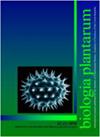Ectopic expression of GmNHX3 and GmNHX1, encoding two Glycine max Na+/H+ vacuolar antiporters, improves water deficit tolerance in Arabidopsis thaliana
IF 0.9
4区 生物学
Q4 PLANT SCIENCES
引用次数: 0
Abstract
The importance of Na+/H+ antiporters in salt tolerance in plants has been demonstrated in many studies, but much less is known about their protective role during drought stress. To study their possible contribution to water deficit tolerance, two closely related soybean Na+/H+ antiporters belonging to the intracellular NHX exchanger protein family, GmNHX3 and GmNHX1, were evaluated in transgenic Arabidopsis thaliana. A. thaliana plants ectopically expressing GmNHX3 or GmNHX1 displayed a more drought-tolerant phenotype compared to wild-type plants, which was accompanied by an increase in relative water content and chlorophyll content during stress conditions. Both GmHNX1 and GmHNX3 transgenic lines accumulated higher amounts of Na+ and K+ cations, showed increased antioxidant enzyme activities and less membrane damage due to lipid peroxidation under water deficit, as compared to non-transformed plants. Furthermore, plants expressing GmNHX3 showed an increased sensitivity to abscisic acid as deduced from stomatal closure and seed germination inhibition studies. Finally, a significant up-regulation of abiotic stress-related genes was observed in both transgenic lines compared to wild-type plants in response to abscisic acid and mannitol treatments. These results demonstrate that GmNHX3 and GmNHX1 antiporters confer protection during drought stress in A. thaliana and hence are potential genetic targets to improve drought tolerance in soybean and other crops.GmNHX3和GmNHX1的异位表达,编码两个甘氨酸最大Na+/H+液泡反转运蛋白,提高了拟南芥对缺水的耐受性
Na+/H+反转运蛋白在植物耐盐性中的重要性已在许多研究中得到证实,但对其在干旱胁迫中的保护作用知之甚少。为了研究它们对水分亏缺耐受性的可能贡献,在转基因拟南芥中评估了属于细胞内NHX交换蛋白家族的两种密切相关的大豆Na+/H+反转运蛋白GmNHX3和GmNHX1。与野生型植物相比,外源表达GmNHX3或GmNHX1的拟南芥植物表现出更耐旱的表型,这伴随着在胁迫条件下相对含水量和叶绿素含量的增加。与未转化的植物相比,GmHNX1和GmHNX3转基因株系在缺水条件下积累了更高量的Na+和K+阳离子,表现出更强的抗氧化酶活性和更少的由于脂质过氧化引起的膜损伤。此外,从气孔关闭和种子发芽抑制研究推断,表达GmNHX3的植物对脱落酸的敏感性增加。最后,与野生型植物相比,在两个转基因系中观察到非生物胁迫相关基因对脱落酸和甘露醇处理的显著上调。这些结果表明,GmNHX3和GmNHX1反转运蛋白在拟南芥干旱胁迫期间提供保护,因此是提高大豆和其他作物抗旱性的潜在遗传靶标。
本文章由计算机程序翻译,如有差异,请以英文原文为准。
求助全文
约1分钟内获得全文
求助全文
来源期刊

Biologia Plantarum
生物-植物科学
CiteScore
2.80
自引率
0.00%
发文量
28
审稿时长
3.3 months
期刊介绍:
BIOLOGIA PLANTARUM is an international journal for experimental botany. It publishes original scientific papers and brief communications, reviews on specialized topics, and book reviews in plant physiology, plant biochemistry and biophysics, physiological anatomy, ecophysiology, genetics, molecular biology, cell biology, evolution, and pathophysiology. All papers should contribute substantially to the current level of plant science and combine originality with a potential general interest. The journal focuses on model and crop plants, as well as on under-investigated species.
 求助内容:
求助内容: 应助结果提醒方式:
应助结果提醒方式:


